What’s required for the software development project to succeed? Proper analysis and research about the software concept, execution planning, business landscape and objective considerations, and the right selection from the list of software development life cycle models. This blog highlights the top 6 SDLC models that you should consider for your modern software development needs.
If you check software development statistics, then a study by the Standish Group’s CHAOS Report reveals that only 29% of IT projects succeed, while 52% are marked as challenged and 19% fail.
The major reasons behind their challenges and failures are inadequate planning, poor communication, unrealistic expectations, scope creep, and lack of stakeholder engagement.
There comes software development life cycle models as a solution.
Hence, in this blog, we’ve covered the top 6 SDLC models in a nutshell, providing their overviews, pros and cons, and best use cases.
| Don’t confuse software development models with methodologies. While models define the structured framework for development, software development methodologies focus on the practical approaches, practices, and philosophies used to execute that framework. |
6 Best SDLC Models in Software Engineering
When it’s about exploring the best models for software development lifecycle, waterfall, V-model, incremental, spiral, iterative, and rational unified processes come as the top choices for CTOs and project managers. Some also consider choosing the Big Bang model for certain requirements.
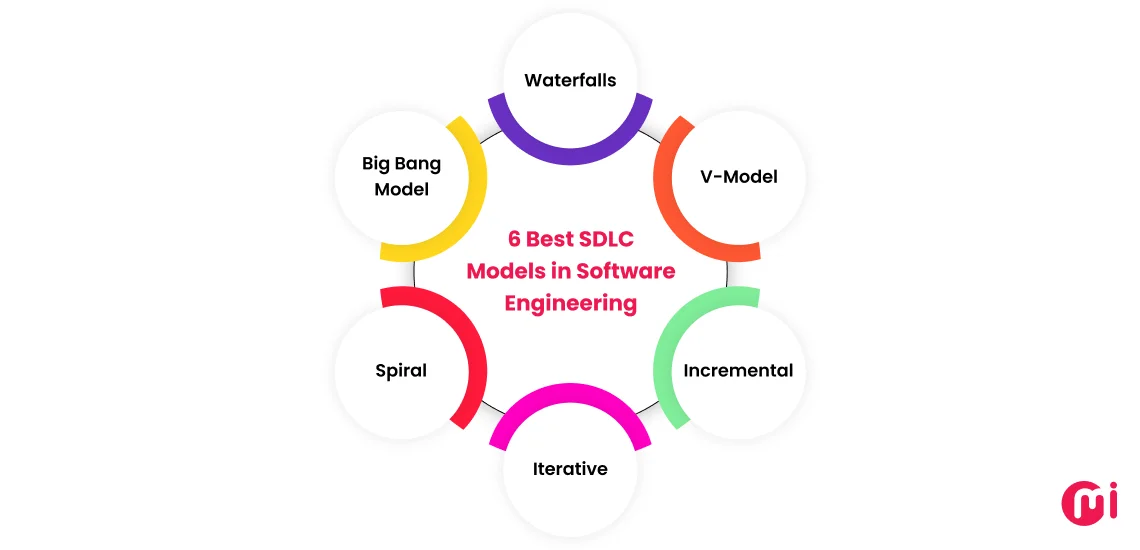

Now, how would you know which suits best for your software development project? Let’s dig deeper into these 6 types of software development models for better understanding:
1. Waterfall Model
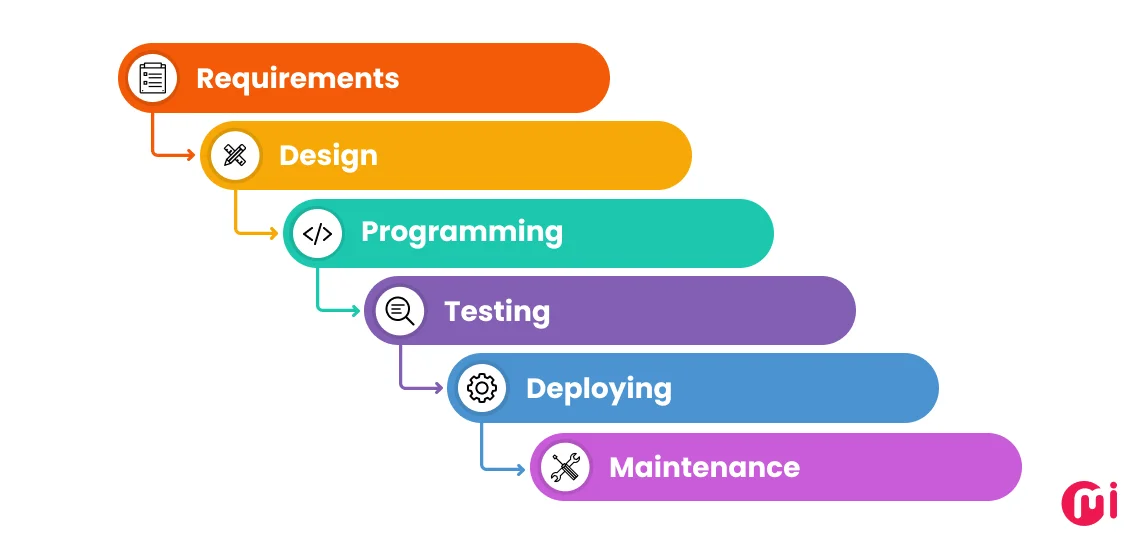

The Waterfall model is one of the earliest and simplest types of software development models. It follows a linear and sequential approach to software development.
It flows down like a “waterfall” through phases, including requirement gathering, system design, implementation, integration & testing, deployment, and maintenance.
The best thing about the waterfall model is that in this, each phase must be completed before moving on to the next, without overlapping or iterations. That’s when there’s a debate around waterfall vs scrum, in which you may be interested.
Best Suited For:
- Clearly defined projects with stable requirements.
- Low-risk and short-duration projects.
- Industry-specific software development projects where regulations and standards are strict (e.g., construction, manufacturing, healthcare, finance, etc.).
- ERP development services-based projects.
Advantages of Waterfall Model
- Clear and sequential structure makes it easy to understand and manage.
- Each phase has specific deliverables and a review process, allowing to predict progress.
- Well-defined requirements and detailed planning in it reduce uncertainty and risks.
- Encourages clear, thorough documentation at each phase.
- Suitable for smaller and fixed-scope projects with unchanging requirements.


Disadvantages of Waterfall Model
- Inflexible to changes once development starts and a phase is completed.
- Minimal client feedback in the process can lead to not meeting user needs.
- Testing often comes at the end of the project, leading to delayed discovery of issues.
- Changes or modifications to the requirements in between the development can cost time and resources.
- Not an ideal model for complex or long-term projects.
| In Summary: You should pick the Waterfall model for your software development project when the scope is well understood and unlikely to change, documentation, reviews, and approvals are important, you need to follow strict regulations or contracts, and testing is only required post-development. |
2. V-Model
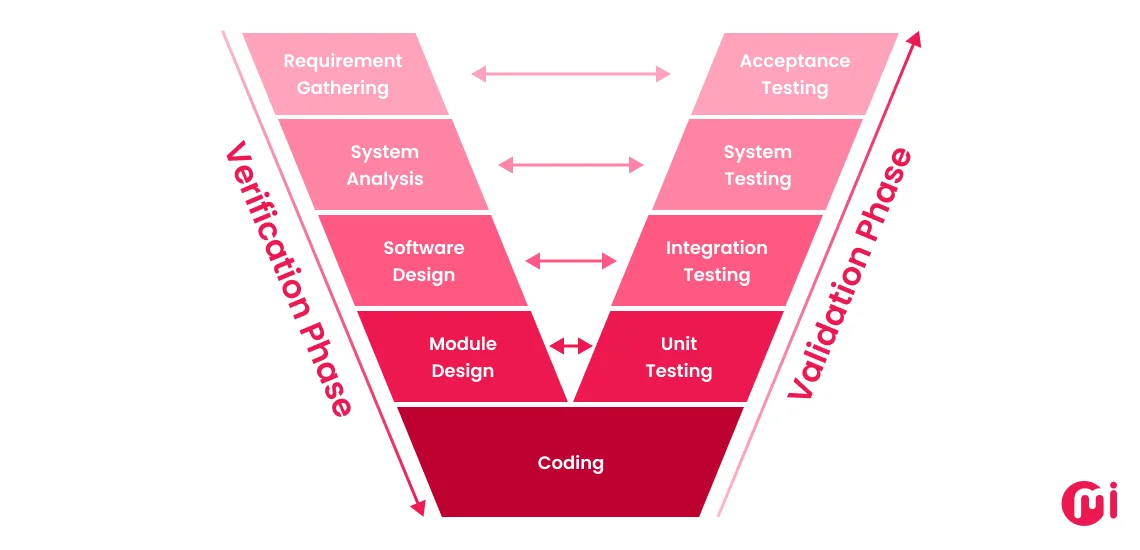

It’s called the “V-Model” because it represents the development (left side of the V) and testing (right side of the V) activities in a mirrored fashion. This setup ensures that each development should have a corresponding testing phase, creating a V-shaped process diagram.
Moreover, the V-model emphasizes two processes: Verification (which answers, “Are we building the product right?”) and Validation (which answers, “Are we building the right product?”).
Key phases of the V-model include:
- Requirements Gathering—>(corresponding to) Acceptance Testing
- Functional Specifications/System Analysis—>System Testing
- Software Design—>Integration Testing
- Module Design—>Unit Testing
- Coding
Best Suited For:
- Healthcare, Fintech, Automotive, or Aerospace industry-specific software development projects, where high reliability and compliance are required.
- Safety-critical systems with no margin for failure.
- Projects with extensive test planning upfront.
Now, let’s have a look at V-model advantages and disadvantages:
Advantages of V-model
- Provides early detection of defects as it puts test planning and design before coding.
- Clear linking between requirements and the final product ensures the software meets needs.
- The verification and validation processes at each stage help to deliver a high-quality build.
- Suitable for small to medium-sized projects with clear and fixed requirements.
Disadvantages of V-model
- The V-model can become rigid and inflexible to incorporate changes after a phase is completed.
- This leads to significant risks and uncertainties if the initial requirement changes in between.
- It is not ideal for complex projects with changing requirements.
- Because it assumes a high degree of confidence in initial requirements, it includes limited user involvement, leading to not meeting user expectations.
- Asks for certain investments in resources for documentation and testing, leading to increased costs.
| In Summary: You should use the V-model when requirements are clear, stable, and well-documented; you need a formal verification & validation strategy; compliance, safety, or precision is non-negotiable; and there’s budget and time for exhaustive testing. |
3. Incremental Model
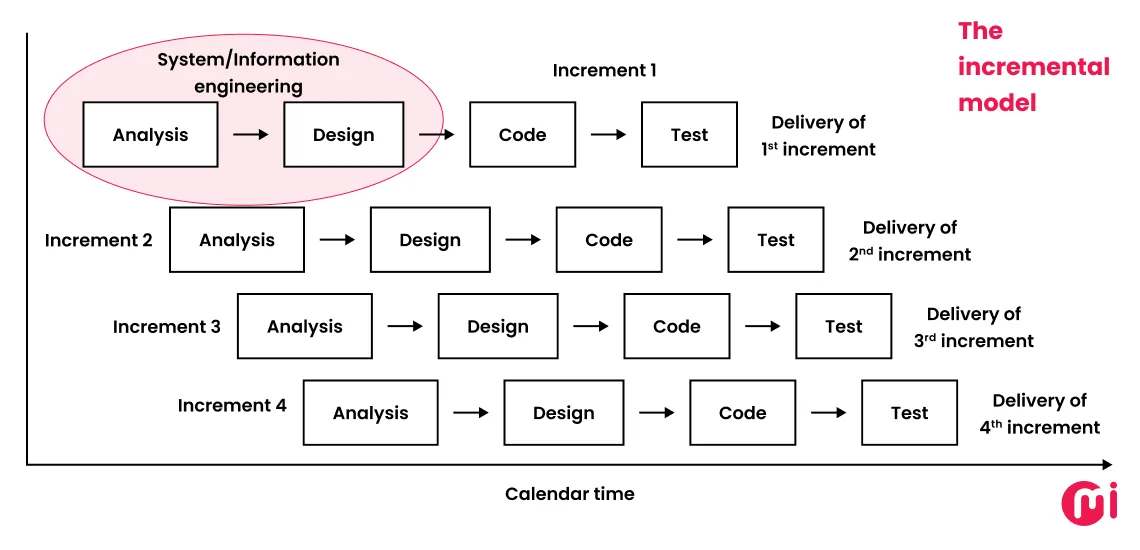

The incremental model is a type of software development life cycle model that includes developing software into smaller modules in an “increment” manner. It evolves in a software development lifecycle as stacks add up one after another. The model continues adding up layers/functional components until the final software product is built.
Phases of the incremental model include requirement gathering, designing, implementation, testing, and deployment.
Best Suited For:
- Medium to large, complex projects with clear module boundaries, like ERP systems and Multi-tenant SaaS platforms.
- Projects with moderate to low risk, like portals or dashboards for internal use.
- Applications needing quick time-to-market (e.g., SaaS development solutions)
- Projects with a clear overall vision but evolving features.
- Projects where funding is received in phases.
- Applications requiring regular user feedback, like consumer apps or EdTech platforms.
Advantages of Incremental Model
- Early and faster delivery of working software.
- Adds involvement of stakeholder feedback in production stages, leading to delivery of software that meets user expectations.
- It’s easy and flexible to incorporate changes and adjustments to scope and requirements in between.
- Risks are addressed in each iteration, allowing for early detection and mitigation of such.
- The overall cost of initial software delivery is lower.
Disadvantages of Incremental Model
- Demands intensive planning and design upfront to complete the build in an incremental manner.
- Not gathering all possible requirements initially can lead to conflict in incorporating future needs.
- The repeated redesign, development, integration, and testing lead to cost increases.
- High chances of inconsistencies and integration challenges due to its flexibility for independent iterations.
| In Summary: You should use the incremental model when the project can be broken into logical, standalone parts; early partial releases are required; you want quicker ROI and stakeholder feedback; and you need controlled, step-by-step growth. |
4. Iterative Model
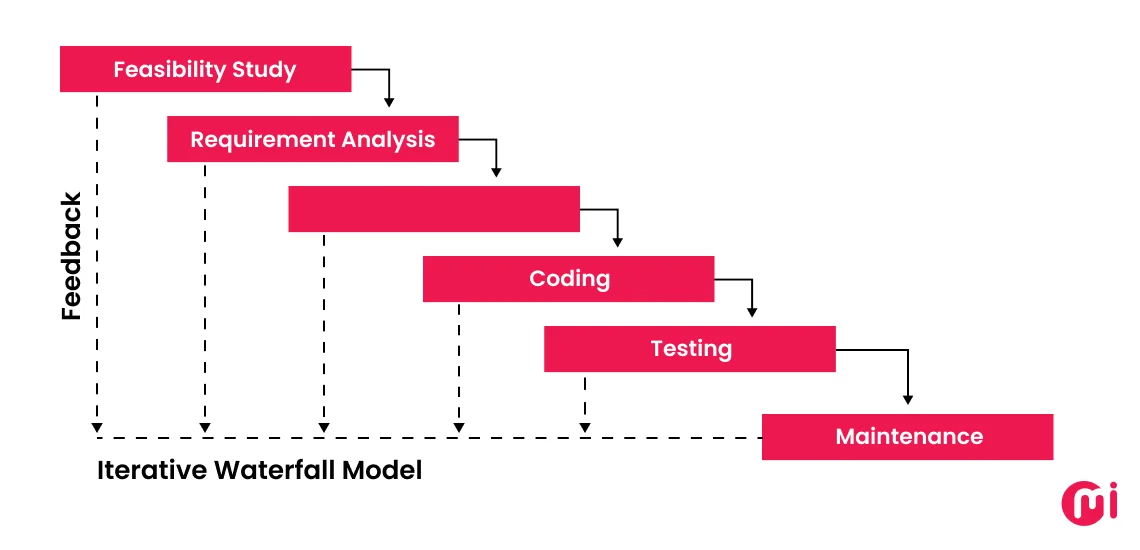

The iterative model focuses on building a simple, initial version of the software first and then enhancing it through repeated cycles (called iterations). Here, each iteration adds improvements and new features based on feedback.
The iterative model mainly focuses on incremental improvements rather than delivering in phases. The best part of this software development life cycle model is that feedback is collected and incorporated after each iteration.
Per iteration, key software development phases include planning, analysis & design, implementation, testing, and evaluation.
Best Suited For:
- Startup software solutions or innovation-driven projects.
- Software product development solutions (B2C mainly) with evolving requirements.
- Mid-sized software projects with moderate complexity, like CMS, eCommerce platforms, corporate internal portals (like ERP, HRMS, CRM, etc.)
- Projects where user feedback is important, like design-heavy apps that need frequent UX validation (Social media, entertainment, games, lifecycle, and educational apps).
- When flexibility is a priority over predictability.
- Legacy system modernization solutions to replacement projects with gradual or feature-by-feature upgrades.
- Projects needing early releases, like MVP development.
- AI/ML and data-driven applications (like when developing predictive analytics in insurance or recommendation engines).
Advantages of Iterative Model
- Flexible and adaptable to handle changes in requirements without significant delays or costs.
- After every iteration, testing is involved, which helps to detect and resolve issues early on.
- Ensures faster software time-to-market.
- Enables stakeholders to receive and provide feedback to align the final product as they need.
Disadvantages of Iterative Model
- Iterative development can require more resources.
- If architecture is not aligned with clear requirements, it can convert into costly rework.
- Managing multiple iterations and changes can be complex.
- Constant stakeholder feedback to add features in each iteration can lead to scope creep, leading to cost and time overruns.
- Not ideal for small projects.
| In Summary: You should use the iterative model when requirements are expected to change, you need early functional versions, continuous feedback and updates are crucial, and the project benefits from learning and refining over time. |
5. Spiral Model
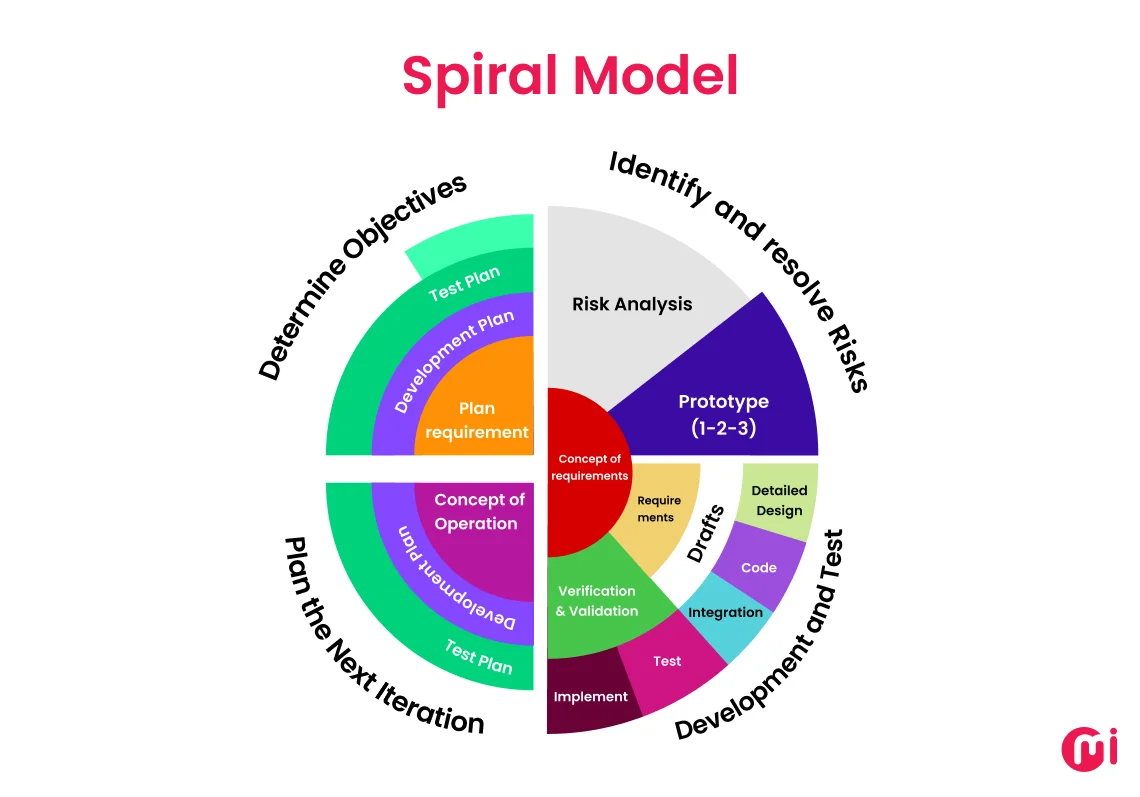

In software development life cycle models, the Spiral Model is a risk-driven approach that combines iterative development with systematic aspects of the waterfall model. Combining all, it executes the development in ”spirals” or cycles.
Per spiral, this model includes phases covering planning, risk analysis, engineering (development + testing), and evaluation, where each loop ends in a review and planning for the next loop.
Best Suited For:
- Large and complex projects with significant risk factors, like complex ERP systems, multimodal CRM platforms, banking, and financial software.
- Building safety-critical systems, like healthcare software, aerospace control systems, etc.
- R&D or innovation-based projects, like AI/ML solutions, IoT frameworks, AR/VR, or metaverse app prototypes.
- Projects with ambiguous or evolving requirements, like legacy system modernization solutions
- Long-term projects with phased delivery, like multi-year digital transformation initiatives.
Advantages of Spiral Model
- Highly flexible and adaptable to changes in requirements and evolving project needs.
- Ideal for high-risk projects as it has built-in risk analysis.
- Supports iterative and continuous development along with feedback loops.
- Emphasizes strong documentation control, helping significantly with project monitoring, risk management, and failure maintenance.
Disadvantages of Spiral Model
- It can be expensive and time-consuming due to its iterative development supportability.
- Its iterative development also leads to scope creep.
- Requires highly skilled personnel and a robust risk management strategy in place to deal with its complexity.
- Not well-suited for smaller or less complex projects.
- Its strong need for strong documentation often imposes a documentation burden.
- Often, it converts into indefinite spirals.
| In Summary: You should use the spiral model when risk management is a priority, requirements are complex or undefined, you need iterative prototyping, and you’re building mission-critical or high-budget systems. |
6. Big Bang Model
The Big Bang model follows a totally unique approach in software development compared to other models. When using this model, there’s no such thing as a specific process or planning strategy. A dedicated software development team starts coding with minimal requirements and directions, and all resources are “exploded” into the development effort.
The phases of the Big Bang model include minimal initial planning, maximum time for coding and testing, and one-phase deployment (at the end of the project).
Best Suited For:
- Proof of Concepts (PoC) or experimental projects. Mostly the ones in the discovery phase.
- MVP development services where speed matters more than scalability
- Student or academic projects
- Internal tools or automation scripts, like quick dashboards or monitoring tools, department-specific apps (custom CRM solutions for sales team)
- Event or conference-specific apps
Advantages of the Big Bang Model
- The model is straightforward to understand and manage.
- Minimal planning requirements reduce the time and effort spent on documentation.
- Projects with limited scope and straightforward functionalities reap the greatest benefits from this SDLC model.
- Offers developers more freedom to adapt to changing requirements and new technologies.
- The simplicity of this model makes projects easy to manage.
Disadvantages of the Big Bang Model
- The lack of planning may lead to the risk of scope creep, rework, and even missed deadlines.
- The lack of structure and control makes it not so suitable for complex or large projects.
- The freedom for development may lead to cost overruns.
- Not prioritizing documentation can hinder future maintenance and modifications.
| In Summary: You should use the big bang model when requirements are unclear or constantly evolving, you’re building something quick, small, and experimental, there’s minimal risk or dependency, and time-to-market outweighs planning precision. |
How to Choose the Right Software Development Model?
No matter which type of software development project you have, to choose the right software development model, you should consider project size & complexity, team expertise, client involvement, risk tolerance, and timeline & budget.
Let’s have a detailed look at factors to consider to choose the right software development model:
1. Project Size & Complexity
Software development life cycle models are different for small- and large-scale projects. If the selected model is ideal for complex projects for your small-scale project, it may lead to costly development. In the vice versa situation, large-scale or highly complex projects may struggle with missing deadlines and complex twists.
The reason is that large-scale or highly complex projects often involve multiple teams, interdependent modules, and long development cycles. If the wrong SDLC model is used, this type of project can lead to miscommunication, missed deadlines, and major rework.
So, the model recommendations are:
- Large, complex projects: Spiral Model, RUP, or V-Model
- Small, straightforward projects: Waterfall or Big Bang
- Growing/mid-size projects: Incremental or Iterative
| 💡Pro Tip: As the complexity of your project increases, you should choose software architecture patterns and models that include risk assessment, modularization, and iterative testing. |
2. Team Size & Expertise
The size and capabilities of your software development team influence how well they can execute a model. Well, size can become a strength or weakness, depending on the software development model you choose. Large teams often require structured coordination, while smaller ones prioritize flexibility more.
That applies the same to the capabilities; a highly experienced team may thrive in iterative or hybrid environments, while junior teams may perform better with rigid, well-defined workflows.
So, the model recommendations are:
- Large and experienced teams: RUP, Spiral, V-Model
- Small and experienced teams: Iterative or Incremental
- Small and less experienced teams: Waterfall or Big Bang
| 💡Pro Tip: Choose a type of software development model that matches your team’s ability and comfort level with planning, documentation, testing, and flexibility rather than overburdening them with models, leading to confusion and delays. |
3. Client Involvement
There are two types of clients/business owners. One type prefers to be a part of software development projects, like working closely with the development team, taking constant updates, and giving feedback. The other category includes those who have their requirements clear and only want to get those to be actualized.
So, there are two different software development models for those two categories of stakeholders:
- High client involvement: Incremental, Iterative, and Spiral
- Low client involvement: Waterfall, V-Model, Big Bang
| 💡Pro Tip: Early-stage startups or fast-moving businesses typically prefer frequent check-ins and rapid iterations, while enterprise clients often lean toward milestone-based progress reports and formal updates. So, you need to go for models that can help you fulfill their requirements. |
4. Risk Tolerance
There are always some sort of risks involved with every software development project, including technical, operational, or business risks. So, you should choose SDLC models based on the risk you identify associated with your business.
- High-risk projects: Spiral Model (best for iterative risk analysis)
- Low-risk/stable projects: Waterfall or V-Model
| 💡Pro Tip: If you think your project may have uncertainties around technology, requirements, or end-user expectations, you should choose a model that allows you to mitigate such midway. |
5. Timeline & Budget
There are two types of software development projects. One has tight budgets and aggressive timelines, while the other has flexible timelines (allowing more room for prototyping, iteration, and refinement).
You should follow these model recommendations to ensure alignment with your software development cost and timeline:
- Strict deadline/budget: Waterfall, V-Model, Incremental
- Flexible deadline/budget: Spiral, RUP, Iterative
| 💡Pro Tip: If you know every changing requirement in your project, you can go for the Waterfall model. If your project has evolving requirements, then the iterative development model helps optimize long-term value without risking early-stage budget overruns. |
Which Software Development Model Suits Your Project?—A Quick Comparison
Choosing the right technology isn’t as simple as picking the one from the software development trends; it asks for technical, operational, risk, and management feasibility studies.
Hence, here we’ve done a table comparison for you to quickly compare software development models and pick the right one for your project:
| Parameter | Waterfall | V-Model | Incremental | Iterative | Spiral | Big Bang |
| Approach Type | Linear & Sequential | Linear + Testing Parallel | Phased Delivery | Repetitive Refinement | Risk-Driven Cyclic | Ad-hoc / Unstructured |
| Flexibility | Low | Low | Moderate | High | Very High | Very High |
| Customer Involvement | Minimal (at end) | Minimal | Moderate (per increment) | High (per iteration) | High (at each phase) | Low |
| Phases Overlap? | No | No | Partially | Yes | Yes | No |
| Best For | Small, defined projects | Safety-critical systems | Medium to large projects | Evolving requirements | Large, high-risk projects | R&D, experimental projects |
| Risk Management | Poor | Low | Moderate | Moderate | Excellent | Poor |
| Cost Estimation | Accurate early | Accurate early | Improves over time | Difficult initially | Gradual & evolving | Very hard |
| Feedback Frequency | End of cycle | After each phase | After each increment | After each iteration | Continuous | Rare |
| Documentation Level | High | Very High | Moderate | Moderate | High | Low |
| Time to Market | Long | Long | Faster (partial delivery) | Moderate | Moderate | Fast (if successful) |
| Project Size Fit | Small | Small to medium | Medium to large | Medium to large | Large | Small |
| Handles Complexity | Poorly | Well (for stable scope) | Well (gradual build) | Well (refinement) | Excellent | Poorly |
Conclusion
Well, in the end, choosing the right software development model isn’t about what’s trending in the market but identifying the one that works in harmony with your project. In this case, asking these questions will help you narrow the choices for software development models logically:
Do you know all the requirements?
How involved is your client?
How much change can you afford?
Moreover, opting for the software discovery workshops can help you get a clear understanding of the SDLC model that works best for your project.
Leverage MindInventory’s Expertise For the Right Software Development Model Selection
At MindInventory, we help you make the strategic choice for the software development model with clarity, confidence, and purpose. Since 2011, we’ve been helping startups, SMEs, and enterprises get software tailored with a software development model that aligned perfectly with project goals, scope, and stakeholder expectations.
Whether your priority is speed-to-market, regulatory compliance, scalability, or client-centric iterations, our experts will guide you through the best-fit model.
Here’s how we help:
- Conduct an in-depth project assessment to understand your scope, risks, and business needs
- Suggest strategic model & customization based on real-world execution experience
- Create a software development roadmap using the selected model
- Execute the software development plan with full visibility
- Provide continuous support, software maintenance & optimization
From software discovery workshops to design to development and beyond that, MindInventory is dedicated to helping you eliminate guesswork and accelerate results with the right development strategy.


FAQs About Software Development Models
If you see, the top 5 software development lifecycle (SDLC) models include Waterfall, V-model, Incremental, Iterative, Spiral, and Big Bang.
SDLC models define the structure and flow of the software development lifecycle, like in how many and what stages, order, and how different phases are connected. On the other hand, software development methodologies are practical frameworks that guide how teams manage work, collaboration, and delivery.
In short, Models = lifecycle structure, and Methodologies = team practices and workflows.
Agile is neither a model nor a methodology but is best described as an approach, a mindset, and a set of principles that guide a flexible and collaborative approach to software development.
At the time of selecting SDLC models, you should avoid these 5 common mistakes:
1. Assuming one-size-fits-all for every project.
2. Ignoring project-specific constraints like budget, risk, and client involvement.
3. Overlooking team capabilities and resource availability.
4. Failing to involve stakeholders in early planning.
5. Choosing a trendy model instead of the most appropriate one.
There’s no universal “best” model – it’s defined depending on your project’s goals, complexity, timeline, and team structure.
If you see, Waterfall is great for clearly defined projects, Spiral is for risk-heavy, evolving projects, Incremental/Iterative offers flexibility for phased delivery, and Big Bang is ideal for small and academic projects where planning can be skipped.
Software product-based startups benefit the most from Incremental or Iterative models as they allow them to start small, validate fast, and evolve based on real-world feedback.
If building a lean MVP, a Big Bang or hybrid agile approach can work too, but only if risks are manageable.
For enterprise-grade software with multiple modules, teams, and compliance requirements, the V-Model is highly effective.
The Spiral Model is the top choice for high-risk projects. Why? Because it emphasizes continuous risk analysis at every iteration, allowing teams to identify, assess, and mitigate potential issues before moving forward.
Incremental and Iterative models allow you to deliver working software in stages, enabling early releases and faster feedback cycles.
Yes, many modern projects use hybrid models by combining elements from different SDLC models.


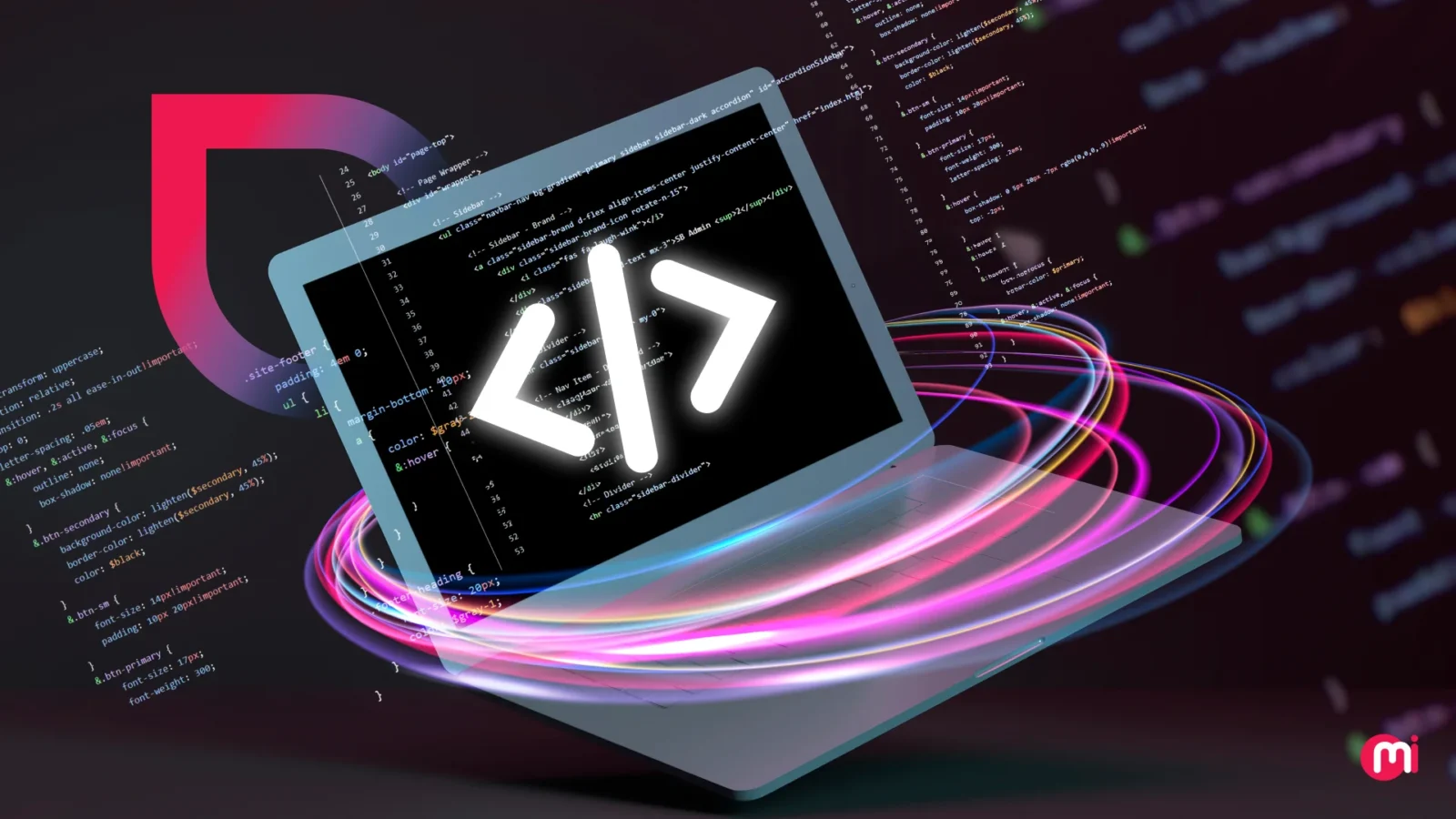










Leave a Reply